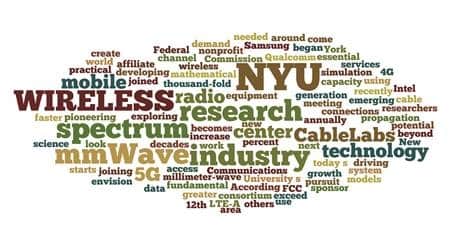CableLabs, the nonprofit research consortium for the cable industry has joined NYU WIRELESS, New York University’s research center, in driving the next generation 5G mobile technology. CableLabs becomes the 12th industry affiliate sponsor of the research center, joining Intel, Samsung, Qualcomm, and others, as the industry starts to look beyond 4G and LTE-A, in pursuit of faster connections and greater access.
As the Federal Communications Commission (FCC) recently began exploring the potential of mobile services in the millimeter-wave (mmWave) radio spectrum—an area in which NYU WIRELESS is developing fundamental science and mathematical channel models needed to create 5G equipment. According to NYU, researchers around the world envision that the new technology using the mmWave spectrum could increase today’s wireless data capacity by a thousand-fold or more—essential for meeting growth in demand that is expected to exceed 60 percent annually for decades to come. The use of the mmWave spectrum towards commercial use, according to NYU WIRELESS, is being driven by its pioneering radio propagation and system simulation work.
The addition of CableLabs as an industry affiliate sponsor is exciting not only because of the depth of research insight it brings, but because it illustrates just how quickly technology leaders are embracing the drive to 5G. The pace is much more rapid than the changeover to 4G—and it promises to vault the U.S. into a leadership position while ushering in a phase of thrilling research and development and products that will create jobs, wealth, and access to extraordinary new services and capabilities.
Dan Rice, SVP, Network Technology, CableLabs
The use of mmWave frequencies provides a viable solution to meet the data-rates and speeds promised by 5G. In order to ensure the most effective use of its capacity, it will require a ubiquitous wired network to offload data. The cable industry has invested a lot in its network and provides a robust and reliable platform for connecting wireless cells to the Internet. Collaborating with NYU WIRELESS enables us to solve the technical challenges of mmWave frequencies for the next generation of wireless broadband


















